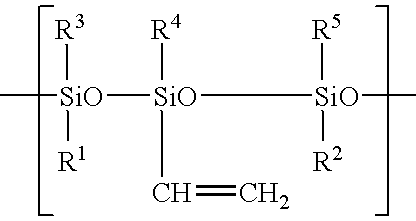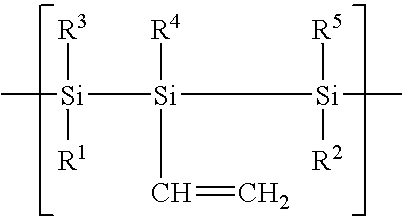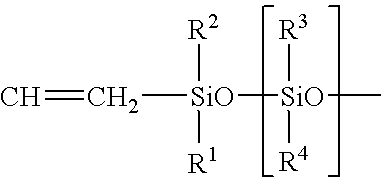Sterically hindered reagents for use in single component siloxane cure systems
a cure system and siloxane polymer technology, applied in the field of siloxane polymers, can solve the problems of insufficient cure rate, inability to use far higher initiation temperature, and only limited pot life of materials at room temperature, and achieve the effect of reducing the rate of crosslinking reaction
- Summary
- Abstract
- Description
- Claims
- Application Information
AI Technical Summary
Benefits of technology
Problems solved by technology
Method used
Image
Examples
Embodiment Construction
[0055]In accordance with the present invention, a Sample is prepared by charging a Braebender mixer with vinylmethylsiloxane-octylmethylsiloxane-dimethylsiloxane copolymer at 75.2 g, 24.8 g of 25–30% methylhydrosiloxane-octylmethylsiloxane copolymer (a crosslinking reagent having a sterically hindered silicon hydride) commercially available under the trade name HAM 301 sold by Gelest, Inc., 0.45 g of platinum carbonyl cyclovinylmethyliloxane catalyst, available under the brand name SIP 6829 sold by Gelest, Inc., and 56.1 g of carbon black available under the trade name Asahi 15HS by the Asahi Carbon Co., Ltd. of Japan. The reagents are mixed for 15 minutes at 25° C. minutes to form a single component matrix mixture.
[0056]The sterically hindered silicon hydride crosslinking reagent in the addition curing systems of the present invention demonstrate significantly longer pot life durations than the prior art. The present invention thus makes it feasible to admix all addition cure polys...
PUM
| Property | Measurement | Unit |
|---|---|---|
| Temperature | aaaaa | aaaaa |
| Temperature | aaaaa | aaaaa |
| Time | aaaaa | aaaaa |
Abstract
Description
Claims
Application Information
 Login to View More
Login to View More - R&D
- Intellectual Property
- Life Sciences
- Materials
- Tech Scout
- Unparalleled Data Quality
- Higher Quality Content
- 60% Fewer Hallucinations
Browse by: Latest US Patents, China's latest patents, Technical Efficacy Thesaurus, Application Domain, Technology Topic, Popular Technical Reports.
© 2025 PatSnap. All rights reserved.Legal|Privacy policy|Modern Slavery Act Transparency Statement|Sitemap|About US| Contact US: help@patsnap.com



